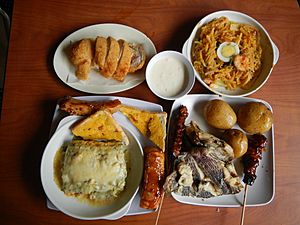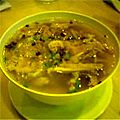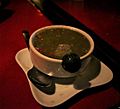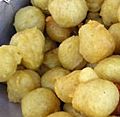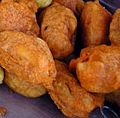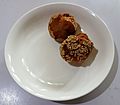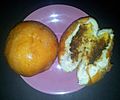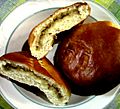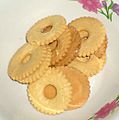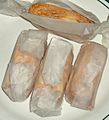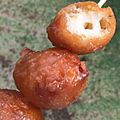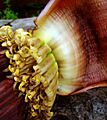List of Philippine dishes facts for kids
This is a list of yummy dishes you can find in the Philippines. Even if some dishes have names like those from other countries, they often taste very different and special in Filipino cuisine.
Contents
- Main Dishes: What's for Dinner?
- Soups and Stews: Warm and Comforting
- Noodle Dishes: Slurp-tastic!
- Vegetables: Healthy and Delicious!
- Rice Dishes: The Heart of Filipino Meals
- Preserved Meats and Fish: Ready to Eat!
- Pickles and Side Dishes: Extra Flavor!
- Miscellaneous and Street Food: Quick Bites!
- Bread and Pastries: Sweet Treats!
- Sweets: Dessert Time!
- Sauces and Condiments: Flavor Boosters!
- Drinks: Quench Your Thirst!
- Ingredients: What Makes Filipino Food Special?
- Images for kids
Main Dishes: What's for Dinner?
- Adobo
- This is a super famous dish! It's usually pork or chicken, or both. The meat is cooked slowly in vinegar, soy sauce, garlic, bay leaf, and black pepper. Sometimes, it's even fried a bit after cooking to make the edges crispy.
- Afritada
- This dish is popular in the Tagalog region. It's chicken or pork cooked with potatoes in a tasty tomato sauce.
- Barbecue (Inihaw, Inasal, Satti)
- In the Philippines, "barbecue" means grilled meat, usually pork or chicken. It's marinated in a sweet and garlicky sauce, then grilled. People often dip it in a soy-vinegar sauce or a sweet brown sauce. Sometimes, even parts like isaw (chicken or pig intestines) are grilled!
- Bopis
- From Batangas, this is a spicy dish. It's made from pork lungs and heart, cooked with tomatoes, chili, and onions.
- Camaron rebosado
- These are deep-fried shrimps covered in a light batter. They are a bit like Japanese Tempura, but with a slightly thicker coating.
- Crispy pata
- This is a delicious, deep-fried pork leg. It's often served with a dipping sauce made of soy sauce, chili, and calamansi (a small lime).
- Daing
- This is a fish dish, often made with milkfish. The fish is dried, salted, or marinated in vinegar with lots of garlic, then fried until crispy.
- Embutido
- Think of this as a Filipino meatloaf shaped like a sausage. It often has boiled eggs stuffed inside.
- Escabeche
- This dish usually features poached or fried fish. It's marinated in a sweet and sour sauce before serving.
- Giniling (Picadillo)
- This dish uses ground pork or beef. It's cooked with garlic, onion, soy sauce, tomatoes, and potatoes. Sometimes, carrots, raisins, and bell peppers are added too.
- Halabos na hipon
- These are shrimps steamed in their own juices with a little oil. Simple and delicious!
- Hamonado
- This is pork cooked in a sweet sauce with pineapple juice and sugar. It's named after the Spanish word for ham.
- Humba
- A slow-cooked sweet pork dish from the Visayas region. It's similar to adobo but uses fermented black soybeans (called tausi).
- Inasal na manok
- From Negros Occidental, this is grilled chicken marinated in a special vinegar sauce. It's often served with pickled papaya (atchara), garlic rice, and yellow oil.
- Inihaw na liempo
- This is simply grilled pork belly.
- Inun-unan
- This is a Visayan way of cooking fish. The fish is cooked in a broth of vinegar, ginger, and other spices. Unlike some other paksiw dishes, it doesn't usually have vegetables.
- Kaldereta
- This is a stew made with pork, beef, or goat meat. It's simmered in tomato sauce, often with liver spread added for a richer taste.
- Kinunot
- From the Bicol region, this dish is made from shredded stingray or baby shark meat. It's cooked in coconut milk with malunggay (moringa) leaves.
- Kinilaw (Kilawin)
- This is a unique cooking method where ingredients are "cooked" using vinegar, similar to ceviche. It's usually used for raw seafood, but can also be for lightly cooked meat or vegetables.
- Lechón
- This is a whole roasted pig, often cooked for special parties. A simpler version is lechon kawali, which is fried pork belly. Lechon manok means roasted chicken.
- Lumpia
- These are like spring rolls! They can be deep-fried (prito) or fresh (sariwa). Popular kinds include lumpiang shanghai (thin, fried, usually with meat) and lumpiang ubod (fresh, with raw vegetables).
- Mechado
- This beef dish gets its name from the word mitsa (wick). Pork fat is inserted into the beef, making it look like a wick, then cooked in a seasoned tomato sauce.
- Paksiw
- This generally means cooking and simmering in vinegar.
- Paksiw na isda is fish cooked in vinegar broth, often with fish sauce and chili.
- Paksiw na baboy is pork, usually leg, cooked in a sweet and sour sauce with sugar and banana blossoms.
- Paksiw na lechon is roasted pork cooked in a special lechon sauce with vinegar, garlic, and liver spread.
- This generally means cooking and simmering in vinegar.
- Palapa
- A spicy condiment from the Maranao people. It's made from pounded sakurab (a type of scallion), ginger, chilies, and salt. It's often served with meat, chicken, or fish.
- Pata tim
- This is a Chinese-style braised pork leg dish. It's simmered in a sweet soy sauce with Chinese herbs like star anise.
- Piaparan
- A spicy Maranao main dish. It's made with palapa, grated coconut, bell peppers, chicken or fish, turmeric, and chili.
- Pinakbet
- A popular vegetable dish from Ilocos. It's made with different vegetables like okra, eggplant, and bitter gourd, cooked in fish sauce.
- Pinangat (Natong or Laing)
- In Bicol, this means taro leaves, chili, meat, and coconut milk, all tied up and cooked. In Manila, it's often called laing. Pinangat can also mean fish poached in salted water and tomatoes.
- Relleno
- This means "stuffed" dishes. Examples include rellenong bangus (stuffed milkfish) and rellenong manok (stuffed chicken).
- Sarsiado
- This is fish cooked in a delicious tomato sauce with fresh tomatoes.
- Sinanglay
- From Bicol, this dish features fish (often tilapia) wrapped in pechay or mustard leaves. It's then simmered in rich coconut milk.
- Sisig
- A famous dish from Pampanga! It's made from fried and sizzling chopped pig's head and liver. Other versions use tuna or milkfish. It's seasoned with calamansi and chili, and sometimes topped with an egg.
- Tapa
- This is dried, cured, or marinated sliced beef. It's usually fried or grilled.
- Torta
- This is like a Filipino omelette. It can be made with ground beef and potatoes, crab meat (tortang alimasag), or roasted eggplant (tortang talong).
- Ukoy
- These are shrimp fritters, often served with vinegar for dipping.
Soups and Stews: Warm and Comforting
- Batchoy
- A noodle soup that started in Iloilo City. It's a flavorful and hearty soup.
- Bicol express
- This is a spicy stew made with long green chilies, coconut milk, alamang (shrimp paste) or dried fish, onion, pork, and garlic. It's very popular!
- Bulalo
- From Batangas, this is a super tasty soup made from beef shank, cabbage, and potatoes. It's simmered for many hours to make it very flavorful.
- Callos
- A rich stew with chorizo (sausage) and beef tripe in tomato sauce.
- Dinengdeng
- An Ilocano soup dish similar to pinakbet. It has fewer vegetables but a stronger bagoong (fermented fish paste) soup base.
- Dinuguan
- A savory stew made with meat simmered in a thick, spicy gravy of pig's blood, garlic, chili, and vinegar.
- Ginataan
- This term means "cooked with coconut milk." There are many ginataan dishes, like ginataang hipon (shrimp in coconut milk) or ginataang gulay (vegetables in coconut milk).
- Kare-kare
- A delicious stew with meat, tripe, and oxtail. It has vegetables and a rich peanut sauce. It's usually served with bagoong alamang (shrimp paste).
- Mami
- This is a general name for noodle soup. It's usually made with beef, chicken, or pork.
- Menudo
- A stew with pork, pig liver, carrots, and potatoes in tomato sauce.
- Nilagang baka
- A beef stew with cabbage, potatoes, and onion. It's seasoned with fish sauce and black pepper. If it uses beef shank with bone and marrow, it's called nilagang bulalo.
- Pancit Molo
- A type of soup using wonton wrappers, from Molo district in Iloilo City.
- Papaitan
- An Ilocano sour soup made with beef or goat innards. The sour taste comes from bile, called papait.
- Pares
- This means "pair." It's usually beef asado (stewed beef) served with rice and a bowl of soup.
- Pochero
- A beef or pork soup stew, often like nilagang baka, but cooked with tomato sauce and pork and beans.
- Sinigang
- A famous sour soup or stew! It's made with pork, beef, or seafood, and lots of vegetables. Sour fruits like tamarind, unripe mango, or pineapple are used to make it sour.
- Sopas
- This is a macaroni chicken soup. It usually has chicken strips, onions, carrots, cabbage, and celery. Evaporated milk is added to make it creamy and rich.
- Tinola
- A soup often made with chicken, green papaya, and chili pepper leaves. It's flavored with ginger, onions, and fish sauce.
Noodle Dishes: Slurp-tastic!
- Pancit lomi
- A Chinese-Filipino dish with thick, fresh egg noodles.
- Misua
- A soup with very thin flour noodles called misua. It can have meatballs, canned tuna, or chicken.
- Pancit luglug
- Similar to pancit palabok, but with bigger noodles. The name luglug comes from the sound made when draining the noodles.
- Pancit canton
- The Filipino version of Chinese lo mein, using flour-based noodles. It's stir-fried with vegetables and meat.
- Pancit bihon guisado
- Stir-fried vermicelli noodles with vegetables and pork or chicken.
- Pancit Tuguegarao or Batil-patong
- A unique noodle dish from Cagayan province.
- Pancit Malabon
- Another type of pancit with shrimp, squid, and other seafood on top. The noodles are thicker than palabok.
- Pancit palabok
- Filipino spaghetti
- The Filipino way of making spaghetti! It has a sweet tomato and meat sauce, often with hotdogs or sausages.
- Baked macaroni
- The Filipino version of macaroni casserole, with a sweet sauce similar to Filipino spaghetti.
- Sotanghon
- A clear chicken soup with vermicelli noodles (sotanghon).
Vegetables: Healthy and Delicious!
- Ginisang monggo
- Sautéed mung beans with onions and tomatoes. Sometimes, coconut milk, dried fish, chicken, or pork are added, along with vegetables like kangkong (water spinach) or malunggay (moringa).
- Kinilnat
- An Ilocano salad made from boiled leaves, shoots, or blossoms. It's dressed with bagoong (fermented fish paste) or fish sauce, and sometimes souring agents like calamansi or ginger.
- Laswa
- A popular soupy dish from the Visayas. It's made with different vegetables like okra, eggplant, malunggay, squash, and tomatoes, served over rice.
Rice Dishes: The Heart of Filipino Meals
- Arroz a la valenciana
- A hearty rice dish with various ingredients like chorizo, carrots, raisins, pork, chicken, and bell peppers. Turmeric gives it a bright yellow color.
- Lugaw
- Plain rice porridge. Don't confuse it with Arroz Caldo, which has chicken!
- Champorado
- A sweet chocolate rice porridge. It can be served hot or cold, often with milk and sugar. Sometimes, people eat it with dried fish (tuyo) for a sweet and salty combo!
- Paelya
- A complex rice dish, usually with seafood like shrimps and mussels. It's inspired by Spanish cuisine and often made for special events.
- Sinangag
- Fried rice cooked with garlic. It's a super important part of the "silog" meal.
- Silog
- This refers to a meal combo of sinangag (fried rice), itlog (egg), and different meats. For example, tapsilog is tapa (cured beef), sinangag, and itlog. Other popular ones are tocilog (with tocino or cured pork) and longsilog (with longganisa or sausage).
Preserved Meats and Fish: Ready to Eat!
- Longganisa
- A Filipino pork sausage, similar to chorizo. There are many regional kinds, like Longganisang Ilocano (garlicky) and Sweet Chorizo from Cebu (sweeter).
- Tinapa / Tuyo
- These are fish preserved by smoking (tinapa) or drying (tuyo).
- Tocino
- A cured meat product, usually pork. It's cured with sugar, which gives it a sweet, ham-like glaze.
Pickles and Side Dishes: Extra Flavor!
- Atchara
- This is pickled unripe papaya in a sweet and sour solution of sugar and vinegar. Other vegetables can also be pickled this way.
- Burong mangga
- Unripened mangoes mixed with sugar, salt, and water to make a sweet and sour pickle.
- Ensaladang talong
- A salad made with boiled or grilled eggplant. It can be served plain, with vinegar and garlic, or with tomatoes, onions, and bagoong alamang (shrimp paste).
Miscellaneous and Street Food: Quick Bites!
- Balut
- A fertilized duck or chicken egg with a partly developed embryo inside. It's boiled and eaten, sometimes with salt or spicy vinegar.
- Binalot
- This means "wrapped." It's food wrapped in banana leaves, usually a meal with smoked or fried meat and rice, sometimes with a salted egg or tomatoes.
- Chicharon
- Mostly refers to fried pork rinds. It can also be made from chicken, beef, or fish skin.
- Fishballs
- A common street food made from cuttlefish or pollock. They're often served with sweet and spicy sauce.
- Isaw
- A popular street food made from barbecued pig or chicken intestines.
- Patupat (or Pusô)
- A type of rice cake wrapped in woven palm leaves or banana leaves and then boiled.
- Siomai
- Ground pork, beef, and shrimp mixed with vegetables, then wrapped in wonton wrappers and steamed.
- Siopao
- A steamed bun with a filling. Common fillings are asado (shredded meat in sweet sauce) and bola-bola (ground pork).
- Tokneneng and Kwek kwek
- These are tempura-like Filipino street foods. Duck or quail eggs are covered in an orange batter and deep-fried. Tokneneng uses duck eggs, while kwek kwek uses smaller quail eggs.
- Tokwa at baboy
- A dish made of bean curd (tokwa, which is tofu) and pork. It's often eaten as an appetizer or with lugaw (rice porridge).
Bread and Pastries: Sweet Treats!
- Binaki (Pintos)
- Steamed sweet corn tamales from Bukidnon and Cebu.
- Binangkal
- Hard and crunchy fried flour balls covered in sesame seeds.
- Biskotso
- Baked bread topped with butter and sugar, or garlic. Popular in Iloilo.
- Buchi
- Crema de fruta
- A layered dessert with sponge cake, custard, gelatin, and fresh or canned fruits.
- Empanada
- A baked or fried pastry filled with ground beef, pork, or chicken, potatoes, onions, and raisins.
- Ensaymada
- A soft pastry, like a brioche, topped with grated cheese (often queso de bola) and sugar.
- Mango float
- A layered dessert made with graham crackers, whipped cream, and fresh mangoes.
- Pan de coco
- A sweet bread roll with a delicious coconut filling.
- Pandesal
- A common bread roll in the Philippines, made from flour, yeast, sugar, oil, and salt. It's often eaten for breakfast.
- Pastel de Camiguín
- A soft Filipino bun with a sweet yema (custard) filling. It's a famous souvenir from Camiguin Island.
- Polvorón
- A crumbly pastry made from toasted flour, milk, and sugar. Sometimes it has peanuts, cashews, or pinipig (crispy rice).
- Roscas
- A pastry cookie from Leyte, made with lard, anise, flour, sugar, and egg yolks.
- Rosquillos
- Filipino cookies from Cebu, made with flour, eggs, sugar, and baking powder.
- Shakoy
- A traditional twisted doughnut from the Visayas islands. Also known as siyakoy or lubid-lubid.
- Otap
- An oval-shaped puff pastry, usually made with flour, coconut, and sugar. Popular in Cebu.
Sweets: Dessert Time!
- Apas
- Oblong-shaped biscuits topped with sugar.
- Banana cue
- Deep-fried Saba bananas coated in caramelized brown sugar. A popular street snack!
- Barquillos
- A thin, sweet, rolled pastry. Sometimes eaten with ice cream.
- Baye baye
- A sticky dessert made from newly harvested rice.
- Belekoy
- A sweet pastry from Bulacan, made from flour, sugar, sesame seeds, and vanilla.
- Bibingka
- A type of cake made with rice flour and coconut milk, baked with coals from above and below. It's usually topped with butter, sugar, and shredded coconut.
- Binignit
- A dessert soup made with coconut milk, root crops like purple yam and sweet potato, and fruits like jackfruit.
- Biko
- A sticky sweet treat made from glutinous rice, coconut milk, and brown sugar. It's similar to kalamay but uses whole grains of rice.
- Bukayo
- A sweet treat popular with kids! It's made by simmering strips of young coconut in water and mixing them with sugar.
- Buko pie
- A traditional pie filled with young coconut meat.
- Camote cue
- Deep-fried sweet potato (kamote) coated in caramelized brown sugar. Another popular street snack!
- Cascaron
- A dessert made of rice flour, coconut, and sugar.
- Coconut jam
- A sweet spread, like a custard jam, made from coconut and sugar.
- Leche flan
- A rich custard made of egg yolks with a layer of soft caramel on top. It's often added to other desserts like halo-halo.
- Dodol
- A sticky, toffee-like sweet made with coconut milk, jaggery (palm sugar), and rice flour.
- Espasol
- A cylindrical cake made of rice flour cooked in coconut milk and sweetened coconut strips, then dusted with toasted rice flour.
- Ginanggang
- Grilled Saba bananas on a stick, brushed with margarine and sprinkled with sugar.
- Halo-halo
- A super popular dessert! It's a mix of shaved ice and milk with various sweet beans, fruits, and other toppings. Served cold in a tall glass or bowl.
- Hopia
- A popular pastry with a bean filling, brought to the Philippines by Chinese immigrants.
- Kalamay
- A sticky sweet treat made of ground glutinous rice, grated coconut, and brown sugar.
- Kutsinta
- A jelly-like rice cake made from rice flour, brown sugar, and lye. It's usually topped with freshly grated coconut.
- Latik
- In the northern Philippines, latík refers to coconut milk curds used as toppings. In the Visayas, it's a thick, sweet syrup made from coconut milk and sugar.
- Maíz con hielo
- Similar to halo-halo, but made with corn kernels and sometimes corn flakes on top.
- Maja blanca
- A local version of blancmange (a creamy dessert) made of coconut milk and corn starch. It can include sweet corn kernels.
- Maruya
- Fritters usually made from Saba bananas.
- Morón
- A type of suman (sticky rice cake) from Leyte. It's made from glutinous rice, with one part flavored with chocolate and the other with coconut milk.
- Nata de coco
- A jelly-like and clear dessert made from fermented coconut water.
- Palitaw
- Flat, round rice cakes made from sticky rice. They float when cooked, then are dipped in grated coconut and served with a dip of sugar and toasted sesame seeds.
- Piaya
- A flat pastry filled with a jam made of muscovado sugar. Sometimes sprinkled with sesame seeds and grilled.
- Puto
- Small, white steamed buns made from rice flour. They come in different flavors like ube (purple yam) and pandan, and can have toppings like cheese or salted duck egg. Often eaten with dinuguan.
- Sapin-sapin
- A layered dessert made of glutinous rice and coconut. Its name means "to spread" or "to cover" because of its colorful layers.
- Sikwate and Puto Maya
- A combination of local hot chocolate and steamed glutinous rice, often served with muscovado sugar and ripe mango.
- Sorbetes
- Traditional Filipino ice cream, often sold by a sorbetero from a colorful cart. It can be made with coconut milk or carabao milk. Flavors include ube, cheese, avocado, and more! It can be served in a cone, cup, or even on bread.
- Suman
- Sticky rice steamed in banana leaves. It's usually topped with a traditional brown sauce or sugar.
- Taho
- A popular morning snack made with fresh tofu, arnibal (brown sugar and vanilla syrup), and sago pearls. It's usually sold by a hawker called a magtatahô.
- Turon
- A typical Filipino snack! It's a banana or plantain (and sometimes jackfruit) wrapped in a springroll wrapper, then deep-fried and sprinkled with sugar.
- Ube halaya
- Ube (purple yam) jam, made from boiled and mashed purple yam. It's also used in pastries and other desserts like halo-halo and ice cream.
- Ube ice cream
- Ice cream made from mashed ube, milk, sugar, and crushed ice.
Sauces and Condiments: Flavor Boosters!
- Alamang (Shrimp paste)
- A paste made from tiny shrimp or krill.
- Bagoong monamon
- A common ingredient, especially in Ilocano food. It's made by fermenting salted anchovies.
- Bagoong terong
- Made by salting and fermenting bonnet mouth fish. It's coarser than bagoong monamon.
- Banana ketchup
- A unique Filipino condiment made from mashed bananas, sugar, vinegar, and spices, colored red.
- Lechon sauce
- Also known as liver sauce. It's a sweet, tangy light-brown sauce used with roasted meats, especially lechon.
- Oyster sauce
- A thick, dark brown sauce made from oyster extracts, sugar, salt, and water.
- Patis (Fish sauce)
- Peanut sauce
- Used with meat and vegetables, adding flavor to grilled meats like satays, or as a salad dressing.
- Tultul
- A type of rock salt from Guimaras.
- Suka (Vinegar)
- An acidic liquid used for cooking and dipping.
- Toyo (Soy sauce)
- A liquid condiment of Chinese origin, made from fermented soybeans. It has a strong umami flavor.
Drinks: Quench Your Thirst!
- Basi
- An alcoholic drink made from sugar cane, popular in Ilocos. If fermented longer, it becomes vinegar.
- Buko juice
- This is simply the water inside a young coconut. Very refreshing!
- Tapuy (rice wine)
- An alcoholic rice drink made from glutinous rice, from Banaue.
- Lambanog
- A strong alcoholic drink made from nipa palm or coconut. Sometimes called coconut vodka.
Ingredients: What Makes Filipino Food Special?
- Atsuete (Annatto seeds)
- Often used to add food coloring to dishes like kare-kare.
- Ampalaya (Bitter melon)
- A vegetable known for its bitter taste.
- Bangus (Milkfish)
- Considered the national fish of the Philippines. Popular in dishes like daing na bangus and sinigang na bangus.
- Batuan
- A fruit used as a souring agent in some dishes.
- Bawang (Garlic)
- A common spice used in many Filipino dishes.
- Bay leaf (Dahon ng Laurel)
- A leaf used for flavoring.
- Bulaklak ng saging (Banana blossoms)
- Used as an ingredient in dishes like kare-kare.
- Kalamansi (Calamondin)
- A small, sour citrus fruit, often used for flavoring and dipping sauces.
- Kamote (Sweet potato)
- A root crop, often used in sweet snacks.
- Kamatis (Tomato)
- A fruit used in many savory dishes.
- Kangkong (Water spinach)
- A leafy green vegetable.
- Kesong puti or Kasilyo
- A soft, white cheese made from carabao's milk.
- Kinampay
- A specific type of purple yam (ube) found mostly in Bohol.
- Labanos (white radish)
- A root vegetable.
- Luya (Ginger)
- A spice used for flavor.
- Malunggay (Moringa)
- A leafy vegetable known for its health benefits.
- Mangga (Mango)
- Considered the national fruit. Eaten ripe or unripe with bagoong.
- Monggo (Mung bean)
- A type of bean used in savory and sweet dishes.
- Okra
- A vegetable with a unique texture.
- Paminta (Black pepper)
- A common spice.
- Pechay (Chinese cabbage)
- A leafy green vegetable.
- Pili Nut
- A type of nut grown only in the Philippines, mostly used in desserts.
- Saba
- A type of plantain often used in cooking and desserts.
- Sayote (Chayote)
- A vegetable.
- Sibuyas (Onion)
- A common spice.
- Siling labuyo
- A very hot chili pepper.
- Siling mahaba
- A long green chili pepper, less spicy than siling labuyo.
- Singkamas (Jícama)
- A root crop, sometimes eaten raw with salt.
- Sitaw (Yardlong bean)
- A long green bean.
- Tabon-tabon
- A fruit used as a souring agent and antiseptic in local dishes, especially Kinilaw.
- Talong (Eggplant)
- A vegetable.
- Tausi (Fermented black beans)
- Used in some dishes for a savory flavor.
- Tilapia
- A type of fish.
- Tofu
- Often used as tokwa (dried tofu) in savory dishes, or as silken tofu in taho.
- Togue (Bean sprouts)
- Used in noodle dishes and other recipes.
- Ube (Purple yam)
- A root crop famous for its vibrant purple color and sweet taste, used in many desserts.
Images for kids

All content from Kiddle encyclopedia articles (including the article images and facts) can be freely used under Attribution-ShareAlike license, unless stated otherwise. Cite this article:
List of Philippine dishes Facts for Kids. Kiddle Encyclopedia.

